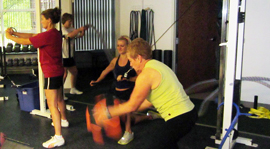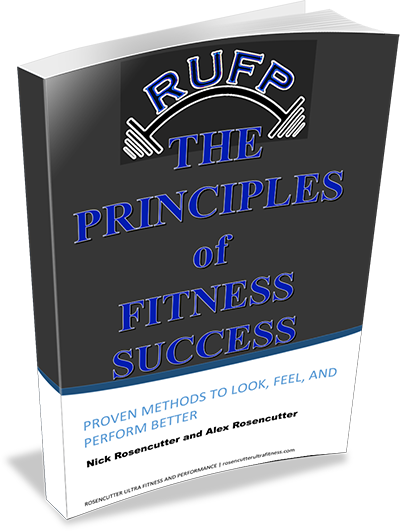Cardiomisconceptia
By: Nick Rosencutter, CSCS, NSCA-CPT, LMT

Thinking back over ten years ago to when I was starting out this whole training thing full time out of college, I remember writing about the priorities of training for fat loss, as there was a lot of misconception out there about what needed to be done to most efficiently spark the metabolic engine and lose fat. Now, today I sit here eleven years later writing about this topic once again, after training hundreds of people. While I would say that the understanding of these things is at least better at this point in time and over a decade later, there are still a lot of people out there who are uneducated and basing their exercise choices off of their “feelings” or what some unqualified social media “expert” said. It is not uncommon to hear something along the lines of “Well I just need to lose some fat first, so I’m gonna do cardio.” (You’ll soon see that this makes no sense) The bottom line is this: When it comes down to the large amount of research done over the last few decades, both academically and in the trenches; and when you understand even basic exercise physiology, it is blatantly clear what is needed for optimal fat loss and I’ll give you a hint: IT IS NOT LONG DURATION AEROBIC “CARDIO.” (though aerobic work is still extremely valuable for its own reasons when used correctly)
In order to understand fat loss from a training standpoint we need to understand how our energy systems work. I’ve covered this in multiple articles in the past so feel free to go back and read more if you are feeling ambitious.
Energy Systems
We have our Aerobic System and our Anaerobic System. Within our anaerobic system, we have our Glycolytic and our Alactic pathways. Each of these systems has its own leadership role with different modes of physical activity. While they all work together with anything that we do, one will be the dominant system utilized for specific activities.
Our aerobic system is primarily responsible for fueling lower intensity, longer duration activities (5 mile jog) while our anaerobic system is primarily responsible for fueling higher intensity, shorter to more moderate duration activities, with the glycolytic pathway taking care of intense activity lasting primarily between 20 and 45 seconds (100 yard sprint) and the alactic pathway taking care of powerful, explosive bursts lasting less than 10 seconds (vertical jump, max squat).
All of these systems are used to produce ATP, a substrate that is like our body’s “gasoline.” We need ATP to fuel activity and for muscle contraction to occur. Our alactic system utilizes a molecule called Creatine Phosphate to help replenish ATP at a fast rate for those explosive short burst activities (yes, this is why people supplement with creatine). When a high intensity activity continues for longer than those 10 seconds, our glycolytic system uses a process called glycogenolysis to break down glycogen (storage form of carbohydrates; yes we need them) stored in our muscle cells into glucose, and eventually ATP, to help keep us at that intensity a little longer. Both of these systems work WITHOUT oxygen. That last point is an important one so remember it. Our aerobic system works WITH oxygen to break down fatty acids and convert leftovers from the glycolytic cycle into a substance called Acetyl COA, which then goes through processes called the Krebs Cycle and the Electron Transport Chain to produce a bunch of ATP. That little sentence there talking about fatty acids is where a lot of confusion sets in with the general public. People assume that since long duration aerobic exercise is utilizing these fatty acids that it is great for fat loss. Well, there are multiple reasons why this is not the case. First, lets sum this up:
Anaerobic System (Alactic and Glycolytic)-
No oxygen, lots of intensity, shorter duration, relatively small amount of ATP produced, can’t go for very long without having to slow down or stop (because we need oxygen to replenish things)
Aerobic System-
Oxygen, lower intensity, longer duration, large amounts of ATP produced, can go for long periods of time since intensity is low enough to allow oxygen to continue shuttling things along
These can be further broken down into Alactic Power and Alactic Capacity, Glycolytic Power and Glycolytic Capacity, and Aerobic Power and Aerobic Capacity. These subsets become more important when you begin training for specific sports and competitions.
Now, building muscle is absolutely and positively the most important component of training if the goal is fat loss. The more muscle that one has, the more fat their body will burn even at rest. It speeds up the metabolism like nothing else and has a myriad of positive effects neurologically, structurally and hormonally throughout the body. Strength training with enough intensity and with the right movements is key and should absolutely be the number one priority of training. While strength training does primarily utilize the anaerobic systems, we are going to focus the rest of this article on conditioning modalities and set the record straight on “Cardio”. (I hate this word as it gets bastardized and means absolutely nothing in regards to the specifics of what you are accomplishing with your training). So you are already lifting hard, now what do we do about conditioning?
Now, as I mentioned before, many people assume that aerobic work is great for fat loss since you are using fat as fuel and burning X number of calories as you do it. While you do burn some fat while you do it, the amount is insignificant when you compare it to the amount that is burned AFTER higher intensity anaerobic exercise. Furthermore, an excessive amount of aerobic work can lead to muscle breakdown, spiked cortisol levels and a decrease in strength and power, which can all lead to more fat STORAGE. (not what you want if your goal is, umm, fat LOSS). A recent study in the Journal of Strength & Conditioning Research compared endocrine and power/strength responses between subjects who either performed strength training alone, strength training and endurance training in a 3:1 ratio or strength training and endurance training in a 1:1 ratio after a 6 week training block. Excessively higher volume of endurance training lead to higher cortisol levels and decreases in strength (1). There are numerous studies over the years showing similar results. This is nothing new under the sun. (Please note the word excessive)
So why do we have this magnificent after effect with anaerobic work? Well, remember when I told you earlier to remember that tidbit about working WITHOUT oxygen? That comes into play now. When we work at those sprint paced high intensities, we put our body into what is known as oxygen debt. If you build up enough of this debt, your body utilizes a phenomenon known as EPOC- Excess Post Exercise Oxygen Consumption. With EPOC, your body burns fat for hours on end AFTER you are done training. Research has shown as many as 38 hours post training. While there are numerous studies on this over the last few decades, THIS (2) is one of my favorites, especially since it was done at UW-La Crosse, where I studied Exercise and Sports Science. The amount of fat calories burned with EPOC ends up rendering the meager amount of calories someone burns during their elliptical workout while watching a soap opera irrelevant. End of story, case closed. You get the same kind of effect after a hard lifting workout. This is precisely why you see all of those people on the ellipticals and treadmills or haphazardly jogging outside doing the same low intensity workout over and over again and never changing. After the first couple of weeks, they never push their bodies to a point of discomfort and never force them to do anything to recover since their intensity NEVER GETS HIGH. And as mentioned above, on top of this, the excessive amount of endurance work that is often done can lead to elevated cortisol levels and muscle loss, which contributes to more fat storage. Coincidentally, the aerobic system is what carries out the recovery from the oxygen debt that is created with anaerobic training. Like I said, all of the systems help each other out. They’re friends for the most part. (However, they can clash and hurt eachother’s feelings, aka adaptations, if programming is not planned appropriately).
Now, in no way am I saying that aerobic training is worthless. It has a ton of value and I’ve written articles about this. Check out this one:_Aerobic is the Word . It is very important for heart health, various aspects of performance, recovery and giving someone the ability to survive the higher intensity anaerobic work that we’ve been talking about. Not to mention, if you do aerobic work correctly, it is by no means a walk in the park. Aerobic power work can be some of the toughest stuff you’ll ever do. Without a good aerobic foundation, you are going to gas out after one or two rounds of anaerobic work and get absolutely nowhere. I’ll say that again: an aerobic base is very necessary to be able to make it through any significant amount of higher intensity work. And no, you’re not going to zap strength and muscle by doing a reasonable amount of aerobic work concurrently. When planned appropriately, aerobic work can actually help improve recovery from strength and power work. It just has to be planned, and not blindly overdone.
Furthermore, one can only handle so much anaerobic conditioning before burning out. Taking a break from this activity and performing aerobic work will keep the body healthy while still allowing for at least some extra caloric output. And it absolutely can help with the overall fat loss journey. It just needs to be planned appropriately and should not be the primary focal point of training when fat loss is the main goal. Another time sticking with aerobic work is beneficial is pre competition or in season. The last thing you need at this time is excess fatigue and burnout from doing a bunch of extra high intensity anaerobic work on top of the sport specific work that is already being done. The right amount of aerobic work can help facilitate some recovery and supplement strength work going into a competition or season (again, provided its not too much and is planned appropriately).
So yes, aerobic work is a great tool that absolutely should be used; however, it should not be misconstrued as a primary fat loss tool if that is the goal at hand, because it is simply not that effective of a tool for this SPECIFIC job. I.e. if your goal is to complete a marathon, then by all means go and do all of the endurance work that you need to, just be sure to plan it and supplement it with the appropriate strength work; and don’t plan on looking that lean or muscular, because you will lose muscle with that kind of endurance volume. If your goal is to lose fat as effectively as possible while building a solid body, then cut the bs, get off of the damn elliptical, stop blindly running unplanned miles and train with a proper program that will give you the physiological effects that you are looking for. (the effects we’ve talked about this entire article) Know what your goal is and know what physiological effect your training is having on your body. Otherwise what is the point?
So, we now have an idea of what is going on behind the scenes with these different modalities of training. How about a few examples of putting them into use? Since we are all quarantined right now, I’ll give a couple of ideas that can easily be done at home with little to no equipment. I’ll cover some glycolytic conditioning guidelines here since they are the most effective modality for fat loss around the clock. See the previously referenced aerobic article for guidelines on that front. These will be a mixture of glycolytic capacity and power.
- Power Jacks– Simply perform jumping jacks as fast as you can without getting sloppy. Do this for 30 seconds as hard and as fast as possible. If you are truly getting into glycolytic mode, your heart rate should be over 170 and you should feel that you need to slow down or stop after the 30 seconds is up. If this is not the case, go faster. Rest 90 seconds and repeat for 8 to 10 rounds. If it seems like 90 seconds is too much rest, you probably didn’t go hard enough.
- Jump Rope– Perform the same layout as the jacks, but use a jump rope. I find that the jump rope essentially forces you to go harder because you have to coordinate your hops with getting over the rope. With either of these examples, just make sure you are prequalified to be hopping and jumping. If you struggle to squat your own weight, I wouldn’t recommend these yet.
- High Step Sprint Marches in Place– Drive your hips and arms as hard and as fast as you can for 20 to 30 second rounds with 60-90 second rest. Do 8 to 10 rounds.
- Bear Crawls– These are always a pretty good ass kicker. Do them at a fast pace and they’re really fun. Be sure to keep your torso and hips solid as you crawl. You shouldn’t be flailing around like a fish out of water. Use the same rounds as above.
- Sprints– Go outside, approximate 80-100 yards and sprint hard. Again, you should be in some kind of decent shape prior to doing this. Rest 2 to 3 minutes between rounds. If you are going hard on these, you should need at least 2 to 3 minutes to recover. If you have one or are in a gym setting, pushing the prowler here works wonders. Perform 5 to 10 rounds. We are looking for maximal power output with each round here, so full recovery is key.
- Stair Sprints– Sprint up and down your stairs for 20 to 30 seconds and rest 90 seconds to 3 minutes depending on how gassed you are. Perform 8 to 10 rounds. 90 second range will be more geared towards capacity while 3 minute plus range will be more geared towards power. Do one for a couple of weeks and then switch. Simply marching fast up and down the stairs may be enough for some of you.
- Bike Sprints– Hop on your bike and pedal as hard as you can for 20 to 30 seconds. Rest for 90 seconds. You can increase rest towards 3 minutes like the last two examples to skew it more towards the power end.
- Boxing– Either with a bag or with air (shadow boxing), throw punch combos at a fast pace for 20 to 30 seconds. Start with a basic jab cross combo. If you are not familiar with this, choose another modality for now.
- Medball or Rope Slams– Leading with your hips and driving with your whole body, repetitively slam the ball or ropes for the same intervals as above.
8 to 10 rounds is a good starting point for most of these. You can also perform two series of 4 to 5 rounds. For example, you do 5 hard rounds, take a prolonged rest (5 to 8 minutes or until you’re close to full recovery) and then perform the second 5 rounds. And yet a third option is to perform these circuit style. Pick 4 to 5 of them and simply go to the next one after the alotted rest period. These are just a few possible examples out of hundreds of possibilities. Whichever route you go, the key is getting the intensity to a high enough level to make your body go glycolytic and create enough oxygen debt to get the after effect we are looking for in order to burn fat calories and get a giant metabolic spike around the clock. In regards to how long these should be done, perform these for around 4 weeks and then perform aerobic work (see other linked article) for 4 to 6 weeks. With general fat loss, this tends to give good results while avoiding burnout and keeping things healthy. If you are new to training, then you will want to perform a cycle of aerobic work first; otherwise, you will not be able to handle the anaerobic work. Athletes training for specific sports will need different guidelines, but that is a topic for another article.
So if you’ve been stuck in a rut for any period of time and your fat loss seems to be stagnant or worse yet, is increasing, there’s a good chance this is the solution you need. Its going be hard work and you won’t be able to watch that soap opera or game show while you do it, but success takes some sweat and guts. Now go train.
Sources:
- (2) Mikat, R P, M D Schuenke, and J M McBride. “Effect of an acute period of resistance exercise on excess post-exercise oxygen consumption: implications for body mass management.” European Journal of Applied Physiology 86.5 (2002): 411-7. pubmed.gov. 29 Jan. 2002. 18 May 2009 <http://www.ncbi.nlm.nih.gov/pubmed/11882927?dopt=AbstractPlus>.
- (1) Jones, Thomas W; Howatson, Glyn; Russell, Mark; French, Duncan N. “Performance and Endocrine Responses to Differing Ratios of Concurrent Strength and Endurance Training.” The Journal of Strength and Conditioning Research. March 2016- Volume 30- Issue 3. P.693-702.



